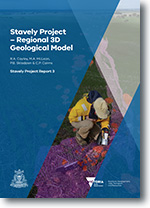Stavely Project Report 3 - Stavely 3D Model Report and Data
 |
| |||||
Product description:Introduction:The Stavely Project is a collaborative geoscience research project between Geoscience Australia and the Victorian Department of Economic Development, Jobs, Transport and Resources (represented by the Geological Survey of Victoria). The aim of the Stavely Project is to improve the understanding of the regional geological architecture and mineral prospectivity of western Victoria, in particular the Cambrian-aged Stavely Arc. Abstract: The STAVELY 3D model is an explicit, full-crustal scale, geological unit and fault-framework model for the central Grampians-Stavely Zone of western Victoria that includes the Cambrian-aged Stavely Arc, prospective for arc-related mineral systems. Built using Paradigm’s GOCAD® software, the STAVELY 3D model honours surface geological constraints and integrates drill hole, geological interpretation of potential field and deep seismic reflection data in and adjacent to the Grampians-Stavely Zone. It also estimates and illustrates how district to regional-scale faults and other structures and rock units mapped at surface, and modelled near-surface, might extend and interact at depth and influence the distribution of near surface geological units of the prospective Cambrian bedrock. The STAVELY 3D model includes at least nineteen fault-bound volcanic belt segments of the Stavely Arc that contain various boninitic to calc-alkaline volcanic rocks and associated intrusions. The volcanic belts are largely concealed by younger Palaeozoic and Cenozoic cover, however where (poorly) exposed at surface they host numerous base and precious metal mineral occurrences. A primary aim of the STAVELY 3D model was to visualise, at crustal-scale, the surface and sub-surface arrangements and inter-relationships of the volcanic belts. The varied and complex distribution of the volcanic belts are the consequence of two main deformation events (D1a and D4), separated in time by 100 million years. Structural controls within Silurian Grampians Group cover constrains removal of D4 effects to reveal a simpler D1 imbricate thrust-geometry for the Stavely Arc at ~505-500 Ma in just four or five long fault-slices. The D4 dextral transtensional event at 400 Ma segmented mineralised (D1a) fault slices of the Stavely Arc, that had also been subject to a mineralising event during D1b. D4 retrodeformation demonstrates how mineralised Cambrian calc-alkaline andesite and porphyry and related Stavely Arc associations in volcanic (fault) belts at Stavely and beneath the Black Range are direct correlates of at least seventeen other Cambrian volcanic belts dispersed under mostly shallow cover throughout the Grampians-Stavely Zone. This represents a nine-fold increase in the viable Cambrian arc-terrane search space for western Victoria. The STAVELY 3D model captures and communicates the interpreted geometries and potential stratigraphic facings of different volcanic (fault) belts of the Stavely Arc, the extent of these belts to depth and beneath younger cover, and the possible inter-relationships that existed between different belts of Stavely Arc at the time of mineralisation (in the Cambrian, up to D1b). This is a new template for improved targeting and systematic mineral exploration of the Stavely Arc. Due to the limited outcrop and poor exposure, and because few mid-or lower-crustal rocks are known within the Grampians-Stavely Zone, the level of uncertainty and ambiguity increases with depth within the model – a range of possible scenarios and inherent strengths and weaknesses are discussed, including a preferred scenario based on data available to the end of 2016, about which the STAVELY 3D model has been built. To limit the impact of this uncertainty on the STAVELY 3D model, wider geological understandings from regions adjacent to the Grampians-Stavely Zone are included; the back-arc and accretionary characteristics of the coeval Glenelg and Stawell zones to the west and east respectively; the wider geodynamic context of the eastern Gondwana margin during, and subsequent to, the Neoproterozoic breakup of the former supercontinent Rodinia; and the far-field geodynamics of the Lachlan Fold Belt farther east that superimposed post-Cambrian deformations onto the Grampians-Stavely Zone. These wider understandings have allowed a geological narrative to be developed that is constrained and consistent with all available data, but not necessarily a unique solution. This narrative was used to assign possible affiliations to buried geological elements that occur at deep levels in the crust, consistent with the range of petrophysical (rock) properties and geometries that are known. Major implications for mineral prospectivity of the Stavely Arc have been realised from the development of the STAVELY 3D model – it is a predictive tool that allows for the direct correlation of Cambrian structures, intrusives, stratigraphy and related mineral systems between disrupted fault slices. Whilst the STAVELY 3D model is constructed at the regional scale to understand and communicate the greater geological architecture, the model has significant implications for area selection and mineral exploration targeting at the district (camp) to prospect/deposit (and even drill hole) scale – this is because of the scale-invariance that is inherent in geology. Applications of the STAVELY 3D model includes, but is not limited to: construction of crustal-scale cross sections in any orientation or position; construction of depth-slices at any depth; identification of common plumbing systems for different or now-separated mineral systems; fluid flow modelling; examining regional structural controls on smaller-scale structural systems; providing a regional framework for detailed geophysical modelling, drill program orientation and optimising geophysical survey acquisition; depth to basement assessments. These applications are facilitated by flexible model portability. The STAVELY 3D model imports successfully into 3D applications including SurpacTM, Micromine, Vulcan and Leapfrog. Bibliographic reference: Cayley, R.A., McLean M.A., Skladzien, P.B., & Cairns, C.P., 2018. Stavely Project - Regional 3D Geological Model. Stavely Project Report 3. Geological Survey of Victoria. Department of Economic Development, Jobs, Transport and Resources. Download: The downloadable version of this report is supplied as 3D Model data (ZIP 2.3GB), 2D volcanic belts (ZIP-SHP 42KB), Report text only (RTF 2216KB), Report High Res (ZIP-PDF 809MB), Report Low Res (ZIP-PDF 26MB) | ||||||

